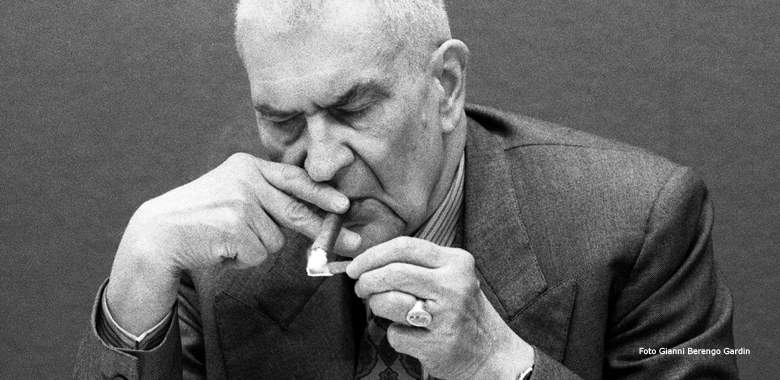Montepulciano hosts major conference on Federico Zeri, at Teatro Poliziano
From October 5 to 7, Montepulciano becomes the capital of art history for three days by hosting the conference Nel segno di Zeri. Conversazioni sulla tutela e la storia dell’arte, all dedicated to Federico Zeri (Rome, 1921 - Mentana, 1998): three intense days of meetings curated by Nino Criscenti and Roberto Longi together with renowned scholars (Tomaso Montanari, Franco Marcoaldi, Sandro Cappelletto, Andrea Bacchi, Alessandro Angelini, Mauro Natale, Anna Ottani Cavina). The conference falls on the 20th anniversary of Zeri’s death as well as ten years after another conference on Federico Zeri held precisely in Montepulciano (the Roman scholar found in Paris the Sodoma’s Holy Family, one of the most beautiful works in the local Museo Civico, which was stolen on December 23, 1970 along with four other paintings and a collection of coins) and will focus on the themes of scientific research in art history and the protection of cultural heritage. All meetings will be held at the Teatro Poliziano and are sponsored by the Montepulciano Municipal Administration, the Museo Civico Pinacoteca Crociani and the Cantiere Internazionale d’Arte Foundation. The promoters also include the Fondazione Federico Zeri of Bologna and the Fondazione Musei Senesi.
Opening on Friday, Oct. 5, will be Tomaso Montanari (University for Foreigners of Siena), with a talk titled “Meno male che c’è stato Napoleone”: Federico Zeri’s indignation for Italian cultural heritage. This will be followed during the day by the screening of several RAI documentaries including Non solo Assisi, Federico Zeri’s journey to Umbria and Marche affected by the 1997 earthquake. In the afternoon, poet and writer Franco Marcoaldi will talk about the protection of the soul. Closing the evening will be a play of images, words and music around a painting in the Museo Civico Poliziano that Zeri held dear: Cristoforo Munari’s Still Life with Musical Instruments. An art historian, Tomaso Montanari, and a music historian, Sandro Cappelletto, will be on stage for a dialogue about painted music, about images of feeling. The words at one point will fall silent to let in the sounds of the instruments depicted in the paintings that will be seen on the screen at the Poliziano, with young musicians performing music coeval to the paintings. The audience will hear Giampiero Allegro’s recorder, Camillo Biagioli’s baroque mandolin, Alessandro Bruni’s guitar on guitar, and Anna-Rikka Santapukki’s virginal.
Saturday, Oct. 6, will be all about art history with Andrea Bacchi (University of Bologna), director of the Fondazione Zeri at the University of Bologna, where the library and the famous Zeri photo library, which has tens of thousands of photographs of works of art from every era and school, with the scholar’s annotations on the back, is kept. Bacchi will recall Zeri’s working method, precisely starting with the tools of investigation. Next, Alessandro Angelini (University of Siena) will review Zeri’s extensive work on Sienese painting. Mauro Natale (University of Geneva) will close the day, with a conversation on Federico Zeri’s main studies, from his book on what he called “timeless art” in Pittura e Controriforma to his famous research on the Barberini Tables in the essay Due dipinti, la filologia e un nome, to his Percezione visiva dell’Italia e degli italiani, an important critical reading of the image of our country in the history of painting. Between conversations, Zeri will be seen and heard in screenings of several Rai documentaries including Ludovica Ripa di Meana’s portrait of him in Una vita con tanti Zeri.
The closing day on Sunday, October 7, will be devoted to Zeri in his entirety, that is, to the man and the scholar: his work, his travels, his friendships, his readings, his whims. Profiling Zeri in his entirety will be Anna Ottani Cavina, the art historian from the University of Bologna who opened and directed until 2014 the Fondazione Zeri, of which he is currently honorary president. The review will close with the voice and face of Federico Zeri on the screen of the Teatro Poliziano in a precious and rare documentary testimony, the interview with him in 1993 by the great French art historian Pierre Rosenberg, former director of the Louvre Museum, for the publisher Umberto Allemandi: a dialogue between two scholars with Zeri at his work table in his villa in Mentana. For info: Fondazione Cantiere Internazionale d’Arte, 0578 757007, or Comune di Montepulciano (0578 7121, comunicazione@comune.montepulciano.si.it).
Pictured is Federico Zeri portrayed in a famous photo by Gianni Berengo Gardin.
 |
| Montepulciano hosts major conference on Federico Zeri, at Teatro Poliziano |
Warning: the translation into English of the original Italian article was created using automatic tools. We undertake to review all articles, but we do not guarantee the total absence of inaccuracies in the translation due to the program. You can find the original by clicking on the ITA button. If you find any mistake,please contact us.





























